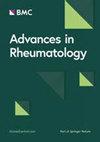揭示复发性多软骨炎的临床表现:对其发病机制、新的单基因病因和治疗策略的见解
IF 2
4区 医学
Q3 RHEUMATOLOGY
引用次数: 0
摘要
复发性多软骨炎是一种罕见的多系统疾病,累及软骨和富含蛋白多糖的结构。诊断这种疾病的主要依据是软骨炎症的发作,尤其是在耳朵、鼻子或呼吸道,更罕见的是出现其他表现。该病的临床表现多种多样,从间歇性发作的疼痛、往往是毁容性的耳软骨炎和鼻软骨炎,到偶尔出现的器官甚至危及生命的表现,如下呼吸道塌陷。人们对这种疾病缺乏认识,主要是因为它很少见。2020 年,一种新型自身炎症综合征 VEXAS(空泡、E1 酶、X-连锁、自身炎症、体质)综合征被描述出来。VEXAS 综合征归因于 UBA1(启动泛素化的主要 E1 酶)蛋氨酸-41 的体细胞突变。这一新的疾病实体将看似不相关的疾病联系在一起:全身性炎症综合征(复发性软骨炎、斯威特综合征和嗜中性粒细胞皮肤病)和血液系统疾病(骨髓增生异常综合征或多发性骨髓瘤)。因此,本文回顾了有关这两种疾病实体的现有文献。本文章由计算机程序翻译,如有差异,请以英文原文为准。
Unveiling the clinical spectrum of relapsing polychondritis: insights into its pathogenesis, novel monogenic causes, and therapeutic strategies
Relapsing polychondritis is a rare multisystem disease involving cartilaginous and proteoglycan-rich structures. The diagnosis of this disease is mainly suggested by the presence of flares of inflammation of the cartilage, particularly in the ears, nose or respiratory tract, and more rarely, in the presence of other manifestations. The spectrum of clinical presentations may vary from intermittent episodes of painful and often disfiguring auricular and nasal chondritis to an occasional organ or even life-threatening manifestations such as lower airway collapse. There is a lack of awareness about this disease is mainly due to its rarity. In 2020, VEXAS (vacuoles, E1 enzyme, X-linked, autoinflammatory, somatic) syndrome, a novel autoinflammatory syndrome, was described. VEXAS syndrome is attributed to somatic mutations in methionine-41 of UBA1, the major E1 enzyme that initiates ubiquitylation. This new disease entity connects seemingly unrelated conditions: systemic inflammatory syndromes (relapsing chondritis, Sweet’s syndrome, and neutrophilic dermatosis) and hematologic disorders (myelodysplastic syndrome or multiple myeloma). Therefore, this article reviews the current literature on both disease entities.
求助全文
通过发布文献求助,成功后即可免费获取论文全文。
去求助
来源期刊

Advances in Rheumatology
Medicine-Rheumatology
CiteScore
4.00
自引率
4.30%
发文量
41
审稿时长
53 weeks
期刊介绍:
Formerly named Revista Brasileira de Reumatologia, the journal is celebrating its 60th year of publication.
Advances in Rheumatology is an international, open access journal publishing pre-clinical, translational and clinical studies on all aspects of paediatric and adult rheumatic diseases, including degenerative, inflammatory and autoimmune conditions. The journal is the official publication of the Brazilian Society of Rheumatology and welcomes original research (including systematic reviews and meta-analyses), literature reviews, guidelines and letters arising from published material.
 求助内容:
求助内容: 应助结果提醒方式:
应助结果提醒方式:


